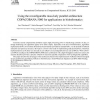Free Online Productivity Tools
i2Speak
i2Symbol
i2OCR
iTex2Img
iWeb2Print
iWeb2Shot
i2Type
iPdf2Split
iPdf2Merge
i2Bopomofo
i2Arabic
i2Style
i2Image
i2PDF
iLatex2Rtf
Sci2ools
PROCEDIA
2010
2010
Using the reconfigurable massively parallel architecture COPACOBANA 5000 for applications in bioinformatics
Currently several computational problems require high processing power to handle huge amounts of data, although underlying core algorithms appear to be rather simple. Especially in the area of bioinformatics, algorithms implemented in PCs do not utilize all hardware functionalities provided by standard CPUs. As the demand for efficient utilization and speed up increases, this leads to a boost in the trend of implementing dedicated hardware. Hardware implementations can be done very fast and are cost effective on reconfigurable devices such as FPGAs. With 128 lowcost FPGAs residing on the COPACOBANA 5000 and in combination with a high-throughput systolic bus system, this machine therefore provides a dynamic solution for massively parallel computations with reconfigurable capabilities. This paper describes the advantages of this architecture based on the implementation of efficient solutions designed for two well-known algorithmic problems in bioinformatics: Smith-Waterman Alignment and...
Related Content
| Added | 20 May 2011 |
| Updated | 20 May 2011 |
| Type | Journal |
| Year | 2010 |
| Where | PROCEDIA |
| Authors | Lars Wienbrandt, Stefan Baumgart, Jost Bissel, Carol May Yen Yeo, Manfred Schimmler |
Comments (0)

